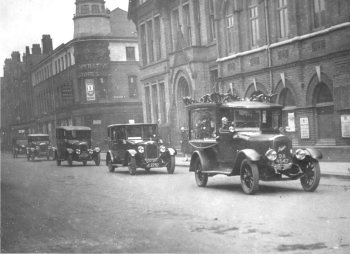Washing Day
When George was young, there were no automatic washing machines,
everything had to be done by hand, wash day was very hard work. The
clothes were put in a tub and agitated, and beaten with a dolly peg.
Once clean, the excess water would be squeezed out using a mangle, and
the garments were hung on the washing line to dry. White items were
soaked in a blue bath to make them look very white and garments such as
shirts were starched. Ironing was no simple matter as the iron had to be
heated by the fire before each use. It was a long and laborious process,
so different from what we do today.
Mondays were washing day. It was terrible, I used to wait for my father
to come from work and give my mother a turn on the mangle. I've given my
mother a turn on the mangle many times on the light things, the cushion
covers and the lace curtains. The heavier things such as the sheets and
the blankets would have to be done by my dad. Of course you mangled by
turning the big wheel on the end of the rollers. It was alright when you
started. You had to adjust the screw on the top to alter the pressure on
the top roller. Eventually the middle of the roller would wear and so
you ended with a concave in the middle of each roller. The wooden
rollers were about 5inches in diameter and about three feet wide. The
pressure eventually would wear the middle away, so no matter how you
adjusted the screw on the top, the two ends of the rollers would prevent
the middle sections coming together and so it was impossible to use
without replacing the rollers.
|

A funeral procession passing the Co op, on
the corner of Whitmore Street and the Poor Hall and Drill Hall.
Photo courtesy of Jennings funeral directors. |
Some people had no money and so couldn't afford to
change the rollers, and so they would use their hands to squeeze out
as much water as possible, or put the washing in the what they
called the dolly tub, which they used to blue-up in, and take off
their shoes and stamp on the clothes to remove the water.
People
used to have two tubs, a big one to maid in and a smaller one to
blue-up in. All of the white things had to be blued up and starched.
You used to get a Reckit's blue, and blue the water. The mixture had
to be just right, too much blue and the clothes would be blue when
they dried. |
| If you got the mixture right the clothes would be whiter than white.
The starch was made with hot water and starch. Put it on and it would
dry hard. Some only just starched the fronts. There was just one washing powder, Hudson's, a hard powder, a slab in
paper, and you had to cut it to size. Its incredible how clean all of
the clothes were got, under the conditions. It was a credit to some of
the women when you look how they did it.
The ironing was done using a sad iron. This had to be heated in front
of the fire on a little straddle, that you used to put on the fire bars
of the grate. Once heated, the iron had to be cleaned before you could
start to iron, because of the dirt from the fire ashes. If you put it
straight on to your washing, the garment you were ironing would be
dirty. It was very hard and slow work, as the iron had to be cleaned
each time it was heated.
Some people used to wash for a living. We lived with my mother’s mother
and she was a good washer. She used to have the job of washing all of
the shirts for the son of Whiteheads, the printers. She was such a good
washer. She used to button the shirts up, iron them and they would be
immaculate. They wouldn’t send them to the laundry because my gran did a
better job.
|
|

|
|
 |
|

|
| Return to
Saturday Night Out |
|
Return to
Daily Life |
|
Return to
the Beginning |
|